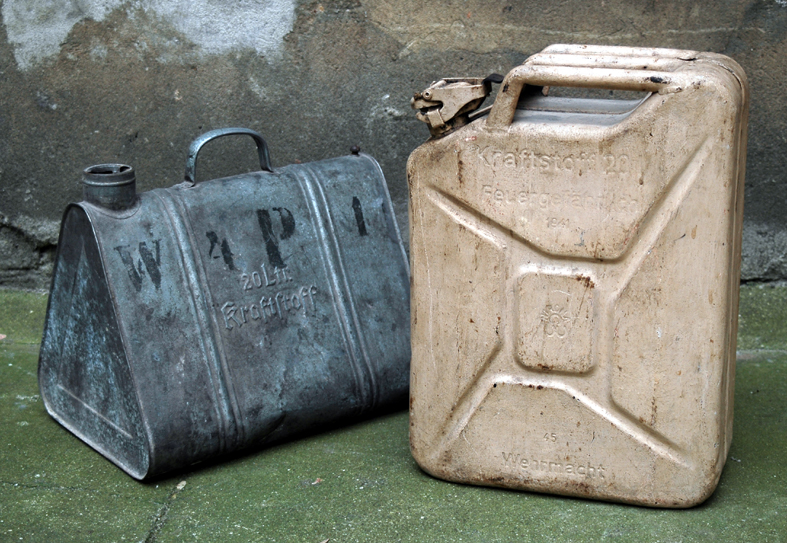
Unbeknownst to many, the ‘jerrycan’ was actually invented by the Germans, and remains a crucial piece of military equipment even today.
You wouldn’t give much thought to something as simple as a can, but these little canisters were key to the Allied liberation of France, and the same can be said for the race to Berlin which would take place later.
So, what’s so special about this can, why is it better than all other cans, how did it come to be, and how did it aid the Allies in winning the Second World War?
The Jerrycan is a German invention
Although it’s known for being used by the Allied forces, the jerrycan is actually a German invention. It was created by one Vinzenz Grünvogel, an engineer with the Müller engineering company in 1937. This first design closely followed guidelines provided by the German army.
According to the guidelines, the can was to be designed in a way for a single soldier to carry two full cans or four empty cans. The cans also had to be stackable so they could be easily transported in trucks and train wagons, and there were even defined times for filling and emptying the can. The cans had a capacity of 20 litres (more than 5 gallons). When full, the can weighed approximately 20 kilograms (45 pounds).

Despite weighing a lot, the cans would still float if dropped into water because of an air chamber at the top, while a special gasket ensured that no water entered the can.
Grünvogel’s design won over the logistics officers at Nazi HQ, and they started mass producing the cans, unknowingly preparing for the upcoming war. By 1939 the Germans had made thousands of them.
Blitzkrieg
Since Germany’s plan was to blitzkrieg through Europe, relying on quick, powerful attacks followed by immediate troop movement, they would need a lot of fuel.
Motorised troops travelled in convoys, and once they got deep into Poland (at first, later in other countries), they couldn’t exactly ask for more fuel to be brought in from Germany. These cans were especially useful in that regard, as German soldiers could simply syphon fuel with a hose and waste very little time on refuelling.
Fuel transport wasn’t the only thing the cans were used for – each can’s insides were lined with a plastic material that allowed both water and gasoline to be transported without contamination. The British had a nickname for the German soldier at this time; ‘Jerry’, thus the term Jerrycan.
Americans learned about it by accident
To be precise – one American learned about it by accident, after which he told American military officials about it. Paul Pleiss, an American engineer who was working in Berlin just before the invasion of Gdańsk, invited his German co-worker on a road trip from Berlin to India (as you do).
Since they didn’t have a car and both of them were engineers, the pair bought a chassis and built their own car (car manufacturing and policing laws weren’t anywhere near as strict as they are today).
WW2 Bomb ‘unexpectedly’ Exploded in Great Yarmouth
To ensure they always had water, Pleiss’s colleague suggested they use jerrycans, which he could take from the Tempelhof Airport. They mounted three of the cans on the car.
Unfortunately (or fortunately – depending how you look at it), the pair of engineers never finished their trip as the German engineer was flown back home after travelling through eleven countries.
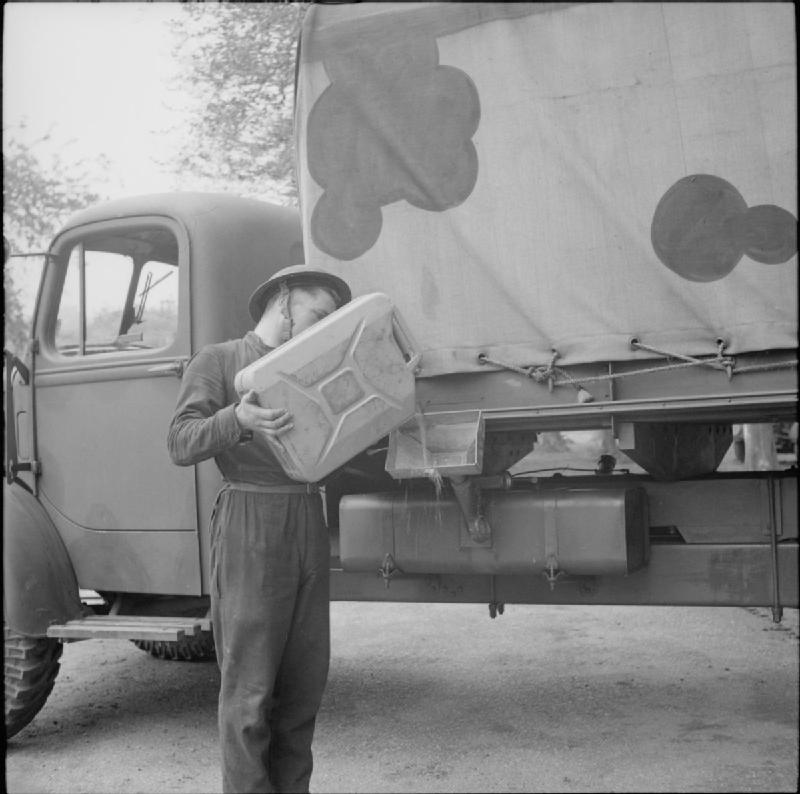
Before leaving, the engineer gave Pleiss the specifications of the jerry can – maybe he was afraid that he would be accused of treason and he wanted some good to come out of the whole ordeal, or maybe he wanted to stick it to the Germans for ruining his trip. Either way, Pleiss had the specifications and travelled with them to Calcutta, after which he went home to Philadelphia.
The road towards American-made Jerrycans was long and twisting
After coming home, Pleiss immediately informed military officials about the can. They couldn’t make anything of his report, though, as he didn’t have a can with him, and they couldn’t witness its usefulness.
Pleiss was afraid of taking the cans with him when he travelled, so he just left them in Calcutta with the car. Now that the military needed sample cans, Pleiss requested his vehicle be sent to him. It took a long time for the vehicle to be shipped, arriving in New York in 1940, when the war was already well underway.
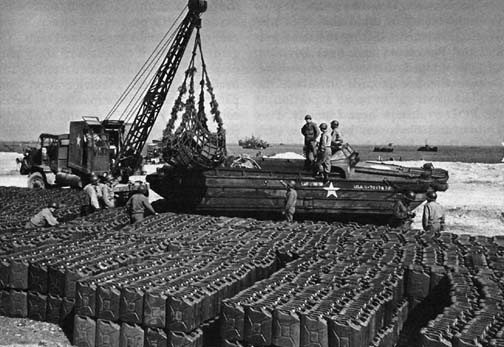
There were three cans in the car – one of them was sent to Washington, the other was sent to Camp Holabird. The officials in Washington determined that the can wasn’t notably better than the improved WWI cans they were currently using.
Jerrycan Design
Camp Holabird designers redesigned the jerry can, focusing only on shape, size, and the handles. There was no inner lining, the cans didn’t float, and they weren’t resistant to hits. They were truly just a bad adaptation of what the Germans did right.
This wouldn’t change until 1943, when Commander Richard M. Daniel of the U.S. Naval Reserve would travel through Egypt just before the Battle of El Alamein and talk to the British about their fuelling process.
The British didn’t want anything to do with American cans as they had already adopted the jerry can and started manufacturing their own (which were a carbon copy of the original German design).
After quick research, Commander Daniel found that the American can was in every possible way inferior to the British and German versions. He urgently contacted his superiors, informing them that the army’s were losing 40% of all Egypt-bound gasoline from America through evaporation and spilling, all because of the can design. At that point, the USA had already produced millions of their own cans.
However, urged by Commander Daniel’s report, American officials cancelled the planned production of their own five-gallon cans, and they made a deal with the British – they would produce cans for all the Allied forces until the end of the war.
The Original British can
Originally, the British used two types of cans. There were the 2-gallon cans (9 litres) and the 4-gallon cans (18 litres). The 4-gallon cans were easier to produce, but their performance on the field was unsatisfactory.
They weren’t as strong as German cans and they’d leak after a few bumps on the road. The fuel would leak out of the cans and present a serious fire hazard. This would lead to the destruction of vehicles transporting the cans.
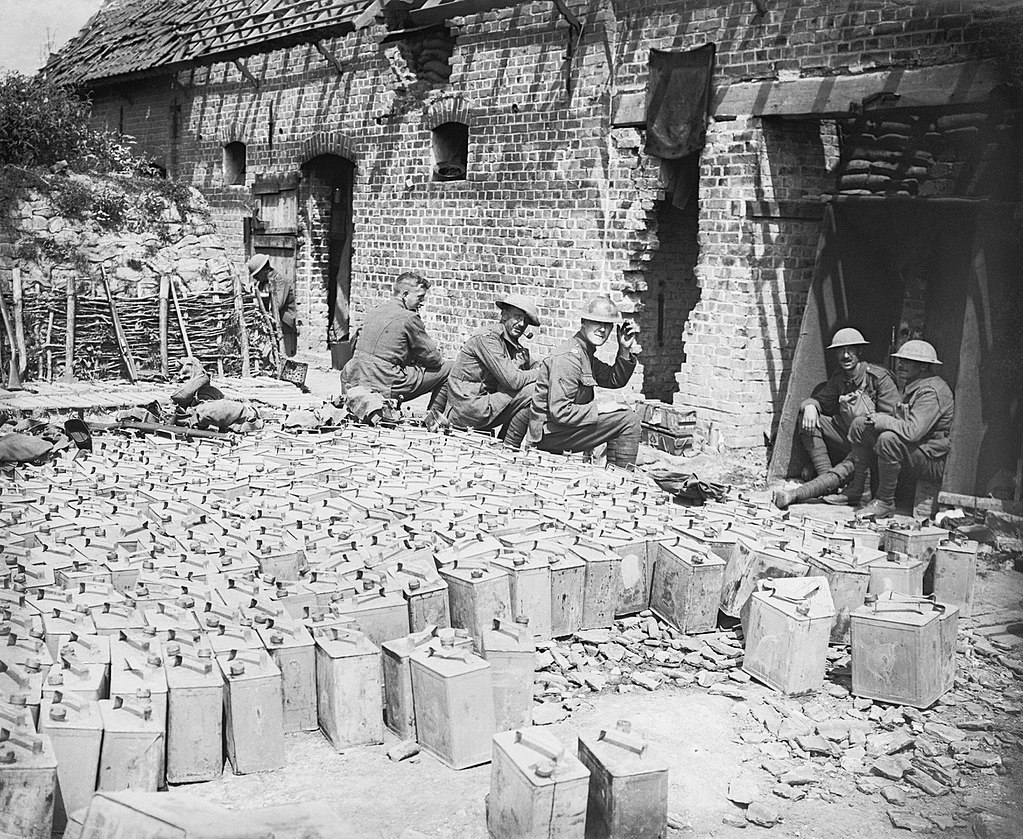
The aforementioned African campaign was especially damning in this regard. Most of the travel there was offroad, making it very easy to crack a can and leak fuel. Not only did this put the transporting vehicle in danger of exploding, but it also significantly damaged the military budget. More than a quarter of the fuel was lost.
The Switch to the Jerrycan
Instead of reusing them, British troops would throw away the cans after using them just once.
Soon, however, that would change. Military officials in London were aware of field reports saying that the Germans had amazing cans. The troops were gladly throwing their own cans away in favour of jerrycans.
Read More: Was Kelly’s Heroes Accurate? Well, it Was Based on a True Story
The story returns to Paul Pleiss. He was in London in 1940 when he had one of his jerry cans flown in from the States. With specifications and field reports on hand, the British immediately organised production of their own cans. Thesewere an exact copy of the German variant.
Commander Daniel assumes that by the Victory in Europe Day (May the 8th, 1945), about 21 million jerry cans were spread among Allied forces. This makes them one of the most widespread pieces of equipment, almost as widespread as guns and ammo.
How did the Jerrycans win the Second World War?
Thanks to their ideal design, jerry cans ensured that troops could transport fuel without losing a single drop of it. At 4.4 gallons per can (20 litres), a single US truck could transport 874 gallons (3310 litres) of fuel (provided they’re stacked properly).
Take the M4 Sherman tank for reference. Depending on the variant, this tank’s fuel capacity ranged between 114 and 174 gallons (520 and 660 litres). On a full tank, it could travel between 100 and 150 miles (160 and 240 kilometres) by road. Also an amazing 60 and 100 miles (97 and 161 kilometres) offroad.
That means that a single truckload of jerry cans (165 cans) could fuel a single M4 Sherman tank for a (745 miles (1200-kilometre) road trip. To put this in perspective – the distance between Paris and Berlin is a little bit more than 621 miles (1000 kilometres).
Knowing that they could always count on their fuel supply (which could only be lost by enemy destruction, not by leaking or getting damaged on the road) provided the Allies with the boost they needed. both mentally and tangibly.
The Allies raced across France thanks to these cans as they never lacked fuel. This was evenacknowledged by President Roosevelt himself in 1944.
Jerrycans today
Although almost an entire century has passed since the Second World War. The jerrycan is still used by most NATO countries as a standard military container for water and fuel.
Since the original invention, many variations have been developed as these cans are commercially available now. The most popular one is still the 20-litre can, but smaller cans exist too.
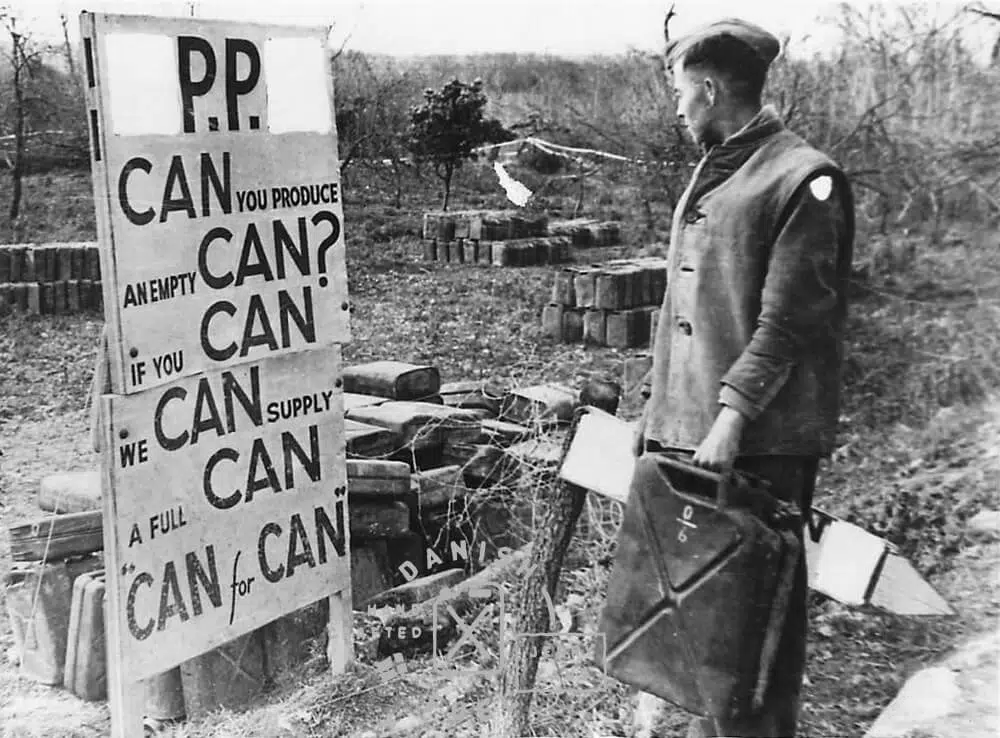
Due to the overwhelming use of plastics in the production market, plastic jerry cans appeared on the market rather quickly. They’re noticeably lighter than metal cans and they’re cheaper to make, which in turn makes them cheaper for commercial sales.
Plastic also can’t rust. But since plastic cans aren’t as sturdy as metal cans, they’re not intended for military fuel use. Nevertheless, jerrycans serve as a reminder that an army is, after all, a complex machine. It requires more than firearms and ammunition. Having stable access to fuel can be a key factor in winning a battle. Its just as important as anything else.